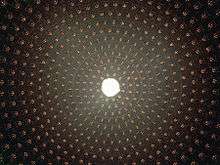MiniBooNE

MiniBooNE is an experiment at Fermilab designed to observe neutrino oscillations (BooNE is an acronym for the Booster Neutrino Experiment). A neutrino beam consisting primarily of muon neutrinos is directed at a detector filled with 800 tons of mineral oil (ultrarefined methylene compounds) and lined with 1,280 photomultiplier tubes.[1] An excess of electron neutrino events in the detector would support the neutrino oscillation interpretation of the LSND (Liquid Scintillator Neutrino Detector) result.
It started collecting data in 2002[2] and was still running in 2012.[3]
History and motivation
Experimental observation of solar neutrinos and atmospheric neutrinos provided evidence for neutrino oscillations, implying that neutrinos have masses. Data from the LSND experiment at Los Alamos National Laboratory are controversial since they are not compatible with the oscillation parameters measured by other neutrino experiments in the framework of the Standard Model. Either there must be an extension to the Standard Model, or one of the experimental results must have a different explanation. Moreover, the KARMEN experiment in Karlsruhe[4] examined a [low energy] region similar to the LSND experiment, but saw no indications of neutrino oscillations. This experiment was less sensitive than LSND, and both could be right.
Cosmological data can provide an indirect but rather model-dependent bound to the mass of sterile neutrinos, such as the ms < 0.26 eV (0.44 eV) at 95% (99.9%) confidence limit given by Dodelson et al..[5] However, cosmological data can be accommodated within models with different assumptions, such as that by Gelmini et al.[6]
MiniBooNE was designed to unambiguously verify or refute the LSND controversial result in a controlled environment.
- 2007
- The first results came in late March 2007, and showed no evidence for muon neutrino to electron neutrino oscillations in the LSND [low energy] region, refuting a simple 2-neutrino oscillation interpretation of the LSND results.[7] More advanced analyses of their data are currently being undertaken by the MiniBooNE collaboration; early indications are pointing towards the existence of the sterile neutrino,[8] an effect interpreted by some physicists to be hinting of the existence of the bulk[9] or Lorentz violation.[10]
- 2008
- Some members of MiniBooNE have formed a new collaboration with outside scientists and proposed a new experiment (called MicroBooNE) designed to further investigate this.[11]
References
- ↑ "Detector". MiniBooNE Experiment Details. Fermilab. Retrieved 2015-12-07.
- ↑ "MiniBooNE website".
- ↑ "Progress in Delivering Beam to MiniBooNE".
- ↑ "KARMEN experiment" (Press release). 3 August 2011.
- ↑ S. Dodelson; A. Melchiorri; A. Slosar (2006). "Is cosmology compatible with sterile neutrinos?". Physical Review Letters. 97 (4): 04301. arXiv:astro-ph/0511500
 . Bibcode:2006PhRvL..97d1301D. doi:10.1103/PhysRevLett.97.041301.
. Bibcode:2006PhRvL..97d1301D. doi:10.1103/PhysRevLett.97.041301. - ↑ G. Gelmini; S. Palomares-Ruiz & S. Pascoli (2004). "Low reheating temperature and the visible sterile neutrino". Physical Review Letters. 93 (8): 081302. arXiv:astro-ph/0403323
 . Bibcode:2004PhRvL..93h1302G. doi:10.1103/PhysRevLett.93.081302. PMID 15447171.
. Bibcode:2004PhRvL..93h1302G. doi:10.1103/PhysRevLett.93.081302. PMID 15447171. - ↑ A. A. Aguilar-Arevalo; et al. (MiniBooNE Collaboration) (2007). "A Search for Electron Neutrino Appearance at the Δm2 ~ 1 eV2 Scale". Physical Review Letters. 98 (23): 231801. arXiv:0704.1500
 . Bibcode:2007PhRvL..98w1801A. doi:10.1103/PhysRevLett.98.231801.
. Bibcode:2007PhRvL..98w1801A. doi:10.1103/PhysRevLett.98.231801. - ↑ M. Alpert (August 2007). "Dimensional Shortcuts". Scientific American. Retrieved 2007-07-23.
- ↑ H. Päs; S. Pakvasa; T.J. Weiler (2007). "Shortcuts in extra dimensions and neutrino physics". AIP Conference Proceedings. 903: 315. arXiv:hep-ph/0611263
 . doi:10.1063/1.2735188.
. doi:10.1063/1.2735188. - ↑ T. Katori; V.A. Kostelecky; R. Tayloe (2006). "Global three-parameter model for neutrino oscillations using Lorentz violation". Physical Review D. 74 (10): 105009. arXiv:hep-ph/0606154
 . Bibcode:2006PhRvD..74j5009K. doi:10.1103/PhysRevD.74.105009.
. Bibcode:2006PhRvD..74j5009K. doi:10.1103/PhysRevD.74.105009. - ↑ M. Alpert (September 2008). "Fermilab Looks for Visitors from Another Dimension". Scientific American. Retrieved 2008-09-23.
External links
- MiniBooNe first results press release and arXiv:0704.1500
- MiniBooNE website
- Overview of MiniBooNE for Mineral Oil Suppliers
- An informal discussion of the experiment and initial results
- Experiment Nixes Fourth Neutrino (April 2007 Scientific American)
- Dimensional Shortcuts - evidence for sterile neutrino; (August 2007; Scientific American)